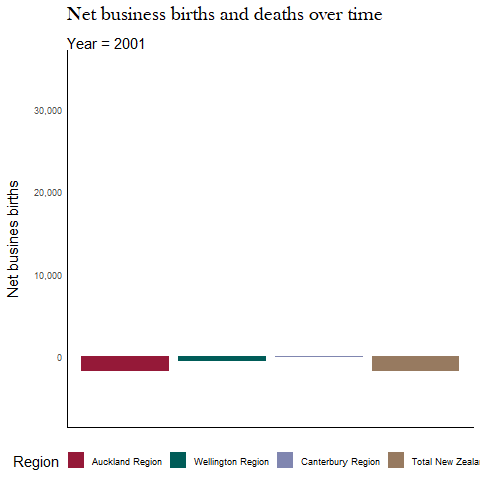The entrepreneur’s role
What is an entrepreneur?
The idea of an entrepreneur seems to be gaining steam as my generation begins to grow passed the early stages of our careers. There is a sort of mystique surrounding such people. Although this mystique is misplaced the entrepreneur is a type of actor critical in economic progress and increasing living standards (dare we say, wellbeing?).
In the midst of the many exciting projects being undertaken by these sorts of people it’s easy to get swept away in their ideas without understanding the more fundamental question – what is an entrepreneur?
We can get data on business births and deaths from Statistics NZ. We know that in some years there are many births and not as many deaths, and in other years there are more deaths than births. We also know that some years there are more births than other years, similarly for deaths.
It’s tempting to look at the trend and conclude: “well if more businesses are born than die then the economy is booming everything is awesome.” But that is not quite correct; in a world of interest rate suppression it is common for business people to overinvest in activities which they would not have done absent the interest rate suppression. Therefore, in years with many business births it could be the case that all these businesses are in unprofitable lines of production. Or, it may not be the case. We do not know.
Even in a world without interest rate suppression it is equally likely to be a good thing from society’s perspective that a business close as it is that a business open. The deciding factor is the particulars of the case.
It’s much more valuable to understand the dynamics behind the data, the people making decisions and how they make them (“why” is left to the psychologists). We can visualise these dynamics using an animated plot of the net business births and deaths over time.

Ignoring whatever minor quibbles about data measurement it’s pretty clear that opening and closing businesses is part of a dynamic economy. But what’s behind the decision to open or close a business in the first place, where, and how?
Who is the individual behind all these decisions?
Taking together the different writers on the topic such as Mises, Kirzner, Bylund I boil the entrepreneur down to the person who, in a world of uncertainty, brings into existence things we want most urgently, at prices generally low enough that we can have them.
This is a loaded description. Firstly, economists think of people having an imaginary list of things they want, ordered from most to least urgent. This is generally not a list of specific goods, but of specific sources of “uneasiness”. Maybe the most urgent is the uneasiness of hunger, followed by the uneasiness of sleeping uncovered. Maybe next is a felt uneasiness of boredom. These feelings of unease can be alleviated with specific goods, like food or a house, and some source of entertainment like a television.
It’s the entrepreneur’s role then to understand the sources of unease for people and figure out how to alleviate those feelings of unease. This takes a remarkable level of empathy, confidence and resourcefulness.
Secondly, how can an entrepreneur bring things into existence? To do so requires capital goods such as machinery and software. These capital goods ultimately come from prior production and savings.
The entrepreneur, then, is like a caretaker, or guardian of a society’s capital. She must use the capital in ways consistent with people’s wishes or suffer the pain of a loss.
And because there is no way of knowing people’s wishes with any certainty, the entrepreneur is also the bearer of risk.
This is a problem of economic calculation – that is, using relative prices as signals to understand what is needed, where it is needed, how it is needed and how it must be produced.
To bring this all into a less esoteric form think of your favourite café. The owner-manager brings into existence delicious coffee and pastries at a specific location where they had not existed previously. These are offered at prices generally affordable to most of the population.
This seems a trivial exercise, surely the Ministry of Everything could do this without breaking a sweat. Until we consider how coffee is made possible. By bringing the seeds of a plant grown in the tropics to New Zealand, heating them in an oven, grinding them to a coarse powder and combining that with hot water and hot milk. The milk itself coming from a four legged beast living many miles away eating grass that was bred specifically to be more nutritious than native grasses and so to yield more milk. This description barely scratches the surface of the complex processes involved in making something like coffee possible. Then we need to consider the pastries…
In order to decide what combinations to use the entrepreneur must weigh up the availability of all of these factors and the importance of their alternative uses. This sounds like an unsolvable problem. But the entrepreneur has access to market prices which convey this information – not perfectly in any sense, but much more effectively than any other method we could possibly derive.
In the next article of this series I will describe my research on Social Entrepreneurship in New Zealand. Starting with a description of how a social entrepreneur could be distinguished from entrepreneurs in general. I will then make more concrete the link between the entrepreneur and wellbeing.